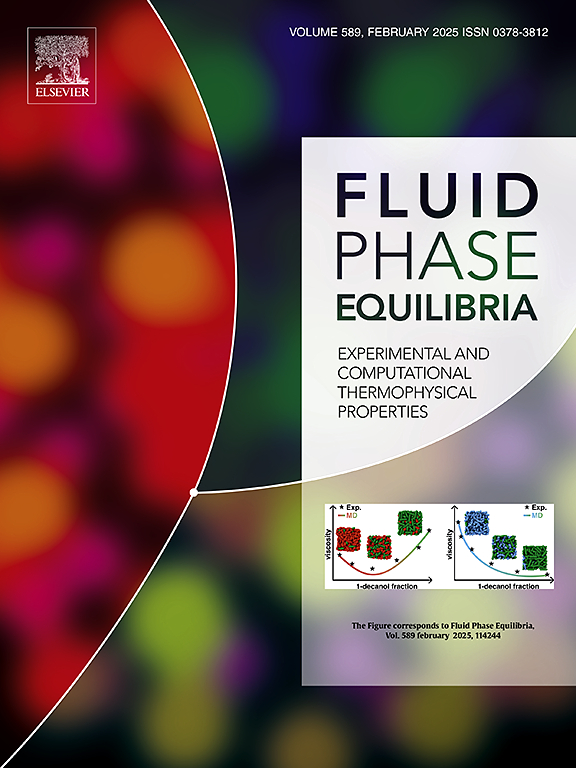Predictive QSPR modeling of pyridine extraction from fuels using deep eutectic solvents: Structural descriptors and neural network insights
IF 2.8
3区 工程技术
Q3 CHEMISTRY, PHYSICAL
引用次数: 0
Abstract
This study employs the Quantitative-Structure-Property-Relationship (QSPR) method to investigate the extractive denitrogenation process of fuels employing deep eutectic solvents (DESs). In this regard, the distribution of pyridine (PY) as a typical nitrogen compound between the hydrocarbon and DES-rich phases was predicted. A comprehensive dataset, covering liquid-liquid equilibrium (LLE) data for 43 ternary systems was collected from various hydrocarbons and DESs containing different hydrogen bond donors (HBDs) and hydrogen bond acceptors (HBAs), enabled an extensive investigation of structural effects on PY distribution. Predictive linear model employing multiple linear regression (MLR) and non-linear models employing multi-layer perceptron (MLP), Radial Basis Function (RBF), Support Vector Machine (SVM), and Random Forest (RF) were developed. The linear model achieved statistical values of R² = 0.8025 and Average Absolute Relative Deviation (AARD) = 21.52 %, while among the non-linear models, the MLP model demonstrated the best performance with R² = 0.9581 and AARD = 9.30 %. The examination of molecular descriptors in the QSPR model demonstrated that PY distribution between the DES and hydrocarbon-rich phases is strongly affected by the average molecular weight of the HBA component and the hydrophilic characteristics of the HBD structure. These observations offer benefical insights for selecting and fine-tuning of molecular structure of DESs in the extractive denitrogenation applications.
使用深度共晶溶剂从燃料中提取吡啶的预测QSPR建模:结构描述符和神经网络见解
本研究采用定量-结构-性能-关系(QSPR)方法研究了深共晶溶剂(DESs)萃取脱氮过程。在此基础上,预测了吡啶(PY)作为典型氮化合物在烃类与富des相之间的分布。研究人员收集了43种三元体系的液-液平衡(LLE)数据,包括不同碳氢化合物和含有不同氢键供体(HBDs)和氢键受体(HBAs)的DESs,从而广泛研究了结构对PY分布的影响。建立了基于多元线性回归(MLR)的预测线性模型和基于多层感知机(MLP)、径向基函数(RBF)、支持向量机(SVM)和随机森林(RF)的非线性模型。线性模型的统计值R²= 0.8025,平均绝对相对偏差(AARD) = 21.52%,而非线性模型中,MLP模型的统计值R²= 0.9581,AARD = 9.30%。QSPR模型中分子描述符的检验表明,DES和富烃相之间的PY分布受HBA组分的平均分子量和HBD结构的亲水性的强烈影响。这些结果为萃取脱氮应用中DESs分子结构的选择和微调提供了有益的见解。
本文章由计算机程序翻译,如有差异,请以英文原文为准。
求助全文
约1分钟内获得全文
求助全文
来源期刊

Fluid Phase Equilibria
工程技术-工程:化工
CiteScore
5.30
自引率
15.40%
发文量
223
审稿时长
53 days
期刊介绍:
Fluid Phase Equilibria publishes high-quality papers dealing with experimental, theoretical, and applied research related to equilibrium and transport properties of fluids, solids, and interfaces. Subjects of interest include physical/phase and chemical equilibria; equilibrium and nonequilibrium thermophysical properties; fundamental thermodynamic relations; and stability. The systems central to the journal include pure substances and mixtures of organic and inorganic materials, including polymers, biochemicals, and surfactants with sufficient characterization of composition and purity for the results to be reproduced. Alloys are of interest only when thermodynamic studies are included, purely material studies will not be considered. In all cases, authors are expected to provide physical or chemical interpretations of the results.
Experimental research can include measurements under all conditions of temperature, pressure, and composition, including critical and supercritical. Measurements are to be associated with systems and conditions of fundamental or applied interest, and may not be only a collection of routine data, such as physical property or solubility measurements at limited pressures and temperatures close to ambient, or surfactant studies focussed strictly on micellisation or micelle structure. Papers reporting common data must be accompanied by new physical insights and/or contemporary or new theory or techniques.
 求助内容:
求助内容: 应助结果提醒方式:
应助结果提醒方式:


